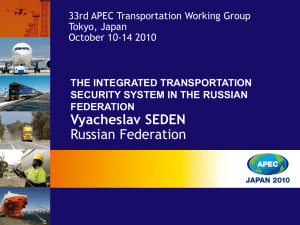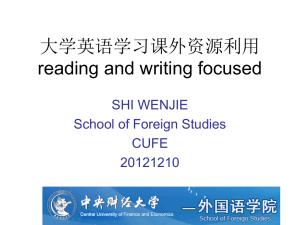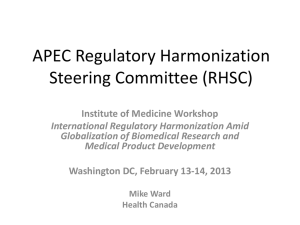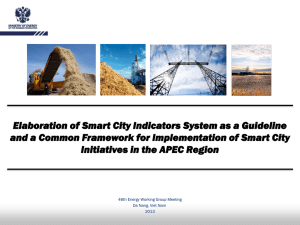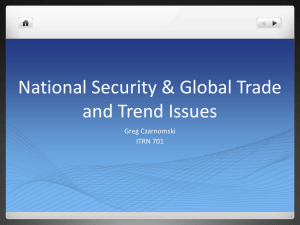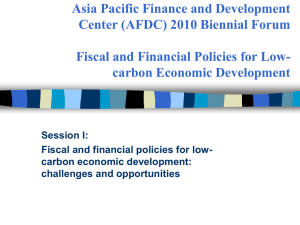`Development`?
advertisement
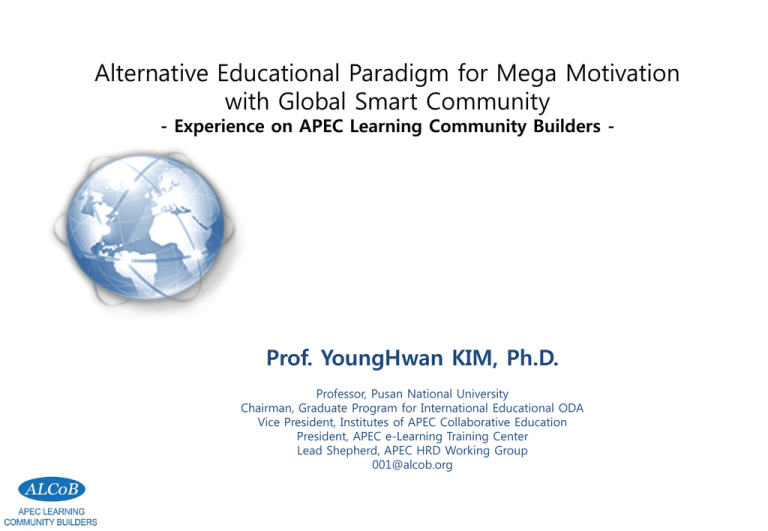
Alternative Educational Paradigm for Mega Motivation with Global Smart Community - Experience on APEC Learning Community Builders - Prof. YoungHwan KIM, Ph.D. Professor, Pusan National University Chairman, Graduate Program for International Educational ODA Vice President, Institutes of APEC Collaborative Education President, APEC e-Learning Training Center Lead Shepherd, APEC HRD Working Group 001@alcob.org 1789 French Revolution 1804 Napoleon 1807 Fichte 1914-18 World War I 1870 FrancoPrussian War 1918 F. Bobbitt Curriculum 1895 Gandhi Against Poll tax 1919 Fascism 1906 F. Taylor Scientific Management 1861 Civil War 1949 R. Tyler Curriculum Model 1908 Ford 1950-54 McCarthyism 1957 Sputnik crisis 1923 Moss Gifts 1991 Dissolution of the Soviet Union 1929 Great Depression 2007 Fiscal Crisis e-Learning Smart Educ Nationalism 1928 Nearing Vermont 1909 F. Ferrer Executed 1849 Thoreau Walden & Civil Disobedience 1901 F. Ferrer Modern School 1896 Dewey School 1917 Nearing Montana 1919 Gandhi 1944 Polanyi The Great Transformation 1919 Waldorff 1860 Tolstoy Civil Education History of Educational System Development 1996 U. Beck Risk Society 1993 J. Rifkin Beyond Beef 1971 I. Illich Deschooling Society 1. Ken Robinson: Changing Education Paradigm 2. Sugata Mitra: Hole in the Wall 3. Edda Dagger: My wish: Once Upon a School 4. Jamie Oliver: Teach every Child about food 5. John Hardy: My Green School Dream Ted 1 Ken Robinson: Changing Education Paradigm Correct! However, only teaching creativity cannot be a good answer. We need a new system. Sugata Mitra: Kids can teach themselves from KalKaji experiment Ted 2 Sugata Mitra: Kids can teach themselves Ted 2 Ted 3 Ted 4 Ted 5 Simple Life: Scott Nearing (1883-1983) & Helen Nearing (1904-1995) An American radical economist, environmentalist, vegetarian, educator, writer, political activist, and advocate of simple living. Type only “good life” in google.com, you will find: Simple living & Self-sufficient economy • Simple living encompasses a number of different voluntary practices to simplify one's lifestyle. These may include reducing one's possessions or increasing self-sufficiency, for example. Simple living may be characterized by individuals being satisfied with what they need rather than want. New Paradigm for education and Schools: Ivan Illich (1926-2002) • Deschooling Society (1971) • Tools for Conviviality (1973) • Making and utilizing opportunity-web for learning and living with – Association with community resources – Utilizing Good examples – Peer-matching and – Partnership with elder persons Karl Paul Polanyi (1886-1964) • Hungarian economic historian, economic anthropologist and social philosopher known for his opposition to traditional economic thought and his book, The Great Transformation. • the originator of substantivism, a cultural approach to economics, which emphasized the way economies are embedded in society and culture. • Developed to the economic democracy movement (ex. Local community-based economy) Sharing: Marcel Mauss • French Sociologist • The Gift(1923) • Giving and receiving and returning gifts create a moral bond and respect in society (ex. North-West Coast Native American potlatch) (1872-1950) Cosmopolitanism • - (U. Beck) "Acknowledging the otherness of those who are culturally different the future nature the object other rationalities World Risk Society: a systematic way of dealing with hazards and insecurities induced and introduced by modernisation itself (Beck 1992:21)".[ We Generation • Me Generation vs. We Generation • Work optimally to have my time for having a good life. • Cooperation and Coconsuming • Mindfulness vs. Walletfulness Eco-friendly re-Creative Village in Columbia “Gaviotas“ OVERVIEW 1971 Founded by Paolo Lugari Attempt to create a model of sustainable living 1976 Appointed as ‘Community Model’ by UNDP Receive funding from UN for Zero Emittion Research Initiative 1977 Awarded by World Clean Energy 1997 Awarded World Zero Emittion [reference] Alan Weisman(1998), Gaviotas 3 Key Principles for sustainability in Gaviotas Creativity (Imagine dreams) Dream and Gather Community Power Community (Bottom-up approach) (students in graduate, professors, technicians, teachers, etc ) Develop appropriate Tech. Secure sustainability based on Nature Receiving Funds from UN, Gov. etc Dissemination the Tech Technology (Appropriate, not brand-new) Key Principle 1 – From Creativity, not from fund [Seesaw Pump] “Children said the pump look like a seesaw. Right away, we started to make the seesaw pump.” Key Principle 1 – Creativity with imagination I .. desolate savannah in Eastern Colombia, without a tree or bird or child in sight. For Paolo Lugari, this was the perfect place to implement a vision: if a sustainable community could be created in such adverse environmental, social and political conditions, it could be done anywhere on the planet. Las Gaviotas has done just that, and much more. [1970s [1990S] Key Principle 2 – Appropriate Technology The Third Development “ Develop their own tech. based on the environment of their community.. Development by the third world, not by the donor countries ” Key Principle 3 – Community Power Survived from political crisis in 1970s affecting many villages in the country “ Why do we do this? That’s because we just like it… The thing that make us move here is not competition or order of rank but something else.” Issues to think and answers in Gaviotas What is ‘Development’? For what and who is the Development? and then, how can we make it? Korean Case: New Town Campaign: Leadership Vision propose Mid & Long Term Plan Nation-wide Participation HR Training, Social Innovation Private leadership, Economic Growth Korean Case: New Town Campaign: Three Elements Self-Help (Ownership) Being Well-Off Movement Diligence (Frontier Spirit) (Affluently, Fruitfully, Joyfully, Fairly Being Well-Off) Affluence in Material + Healthy Mentality Community Movement for Being Well-Off Together (Pray for Personal Desire & People’s Prosperity) Collaboration (Community Spirit) Page 29 Korean Case: New Town Campaign: Pump Theory Virtuous Circle Investment and Development in Private Sector Employment Creation Virtuous Circle Korean Case: Progress of New Town Campaign The Beginning Period(1970’) Global Model for Local Community Development Movement Rural Modernization, Overcoming Poverty, Motive of Nation Modernization(Government Policy period) The Middle Period(1980’) Performing as a Key Role of National Mind Movement. Establishment of Saemaul Movement Association, Successful Host of 1986, 1988 Olympic (Private-Government Collaboration period ) The Latest Period(from 1990’) Pointing to National Movement as Volunteers Expanding Capacity as a National Maximum and the Best Volunteer Organization (Private Leading Period) What is ALCoB? Representative human network in the APEC region Background 2003 Approval of “APEC Learning Community for Shared Prosperity (ALCom)” at the 25th APEC HRD Working Group Meeting ALCoB Activities Autonomy Cooperation Understanding Volunteerism ALCoB Edutainment Exchange Program Annual International ALCoB Conference 2014 2013 2012 2011 2010 2009 2008 2007 2006 2005 2004 2003 2002 2001 APEC Internet Volunteer 1999 APEC Summit APEC Edutainment Park System e-ICON World Contest APEC e-Learning Training 10th APEC Future Education Forum APCJ: Asia-Pacific Collaborative Journal ALCoB –Objective and Role Objective To materialize the APEC Learning Community based on autonomy, understanding, cooperation and volunteerism Roles • Narrowing the digital divide in regard of educational informatization & ICT Usage among APEC member economies • Enhancing cooperative activities on collaborative study in the education & HRD field among APEC member economies • Discussing the direction and model of future education & sharing experiences and results in each economy ALCoB Composition Teachers ALCoB-T Supporters: government officials, professors, researchers, etc ALCoB-S Learners: K-12 students ALCoB-L University Students ALCoB-U Business Sector ALCoB-EC Currently, around 5,000 leaders from 22 member economies including the participants from APEC ICT Model Schools, APEC e-Learning Training Program, AIV activity and local community ALCoB History AEEP Project & Education Exchange Education Exchange Set Policy Direction Research & Development Consulting & Supporting Education ALCoB Branches The Russian Federation IACE, Korea (Head Quarter) Mexico The Philippines Indonesia *In a process in Malaysia Thailand Indonesia ALCoB Structure Total 40 branches as of May 2012 since 2001 starting from ALCoB Internet Volunteer activity, APEC e-Learning Training Program, (domestic) ALCoB conference, etc Thai ALCoB As One of most active ALCoB member economies, welcome new Thai ALCoB branch in Khon Kaen with many thanks to Thai Ministry of Education, TCU, Chulalongkorn University, Sripatum Universityand all Thai ALCoB members..! 1. Holistic Systemic Change Model Korea Development Model ALCoB’s Experiences & Know-how Leadership of Leaders CoP(Community of Practice) HR Training, Social Innovation Advanced Technology Private Sector Development Systemic Change Model New Development Model 1 Change Attitude (Confidence) 2 Mid-Long Term Vision 3 Training Next Generation Leaders 4 Leaders Community 2. Optimal Usage of SMART Technology Collective Intelligence Nationwide Advanced Team More Diffusion Expert Team Core Team Aligned Vision Key Area 3. Tri-partized Approach Holistic Systemic Change Philosophy • Urban Rural Disparity settlement through IT and HRD System (ICT) • Smart Media Center • Online contents and support system Human Resources • Agent for a change-led development • Community based Human Resources 4. Convergence with Education & HRD Business Medicine Marine & Fishery Architecture Education & HRD Agriculture Technology Industry Philosophy 5. Building community then funding later Global Collective Intelligent Community New Town (Korea) • Cooperation • Self-help • Diligence Gaviotas (Columbia) • Creativity • Community • Proper Tech ALCoB • Volunteerism • Global Community • Smart Technology 6. Tri-partized HRD Tri-partized Smart Mentoring Youth City Urban Adults Retired 7. Simple but meaningful and healthy life • Good development = SMS Development Sustainable + Meaningful + Self-sufficient Campaign for – – – – Simple cloths Proper food + Proper work Optimal house Mindfulness SMART Systemic Change with ALCoB Step by step Gradual Expansion Attitude & Mind Knowledge Environment Community Organization (Ability to Propagate) Youth Business Adults Retired Government Academy Connection between Industry-Academy & City-Rural Area Education & HRD SMART Tech. Simple Life with Collective Intelligence Human Resources Development Human Relationship Development


